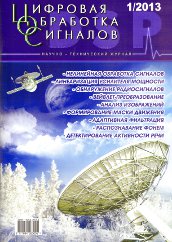|
“Digital
Signal Processing” No. 1-2013 |
|
D.A. Lednov
Analyzing Hidden Trajectory Models (HTMs) of Vocal Tract Resonators for
Phoneme Recognition System
Original works on phoneme recognition by Li Deng and his colleagues (Microsoft)
published in 2000-2010 have been translated and are analyzed in the paper.
The main trend of these publications is associated with developing the
model for hidden trajectory parameters of vocal resonators. The development
shows the functional relation of linear prediction coefficient dynamics
to vocal tract resonator parameters having been smoothed by FIR-filter.
Statistical model for the relation given is introduced and optimized.
The model developed is completed with continuity equation to determine
FIR-filter features for each phonetic state. The author also introduces
an alternative optimization diagram to estimate parameters of a statistic
model.
D.A. Lednov, e-mail: lednov@stel.ru
E.B.Solovyeva
Cascade Precompensator for Power Amplifier Linearization
Cascade structure
of nonlinear digital precompensator being synthesized by a direct learning
algorithm is proposed. Cascade precompensator including polynomial perception
network and radially pruned Volterra model is proved to provide the most
exact linearization for power amplifier with Wiener-Hammerstein model.
E.B.Solovyeva, e-mail: selenab@hotbox.ru
K.A. Batenkov
Mathematical Modulator/Demodulator Models with Specified Nonlinearity
Order
Mathematical modulator/demodulator models with a specified nonlinearity
order based on functional series are synthesized. Signal processing complexity
is estimated depending on the quantity of basis functions used.
K.A. Batenkov, e-mail: pustur@yandex.ru
D.A. Pimankin
Method of Weighted Least Squares for Image Analysis
A method of making a feature description for image areas based on analyzing
image gradient vector orientations using a method of weighted least squares
(WLSF method) is proposed. For a large class of images the method is sure
to be a success in solving the problem of matching key points. The advantage
of WLSF method compared to SURF method while analyzing noisy images is
proved.
D.A. Pimankin, e-mail: denis@pimankin.com
P.V. Kalinin, A.A. Sirota
Modeling Applicative Noise of Random Shape and with Various Opacity Degree
A generalized
model for applicative noise on images as a set of local occlusions of
random shape and with a various opacity degree is proposed. Variants to
implement algorithms for modeling applicative noise and to control parameters
of intensity, connectivity, opacity and shape irregularity degree are
considered.
P.V. Kalinin, e-mail: kalinin_pv@sc.vsu.ru
A.A. Sirota, e-mail: sir@cs.vsu.ru
E.I. Minakov, D.S. Kalistratov
Method of
Constructing ALFA-mask
A method of constructing alfa-mask based on the principles of arithmetic
context-dependent coding is considered. A method of constructing alfa-mask
based on a dynamic regenerating for a movable part of the mask is proposed.
Structural synthesis and comparative analysis for videocodec models using
the above methods are performed.
E.I. Minakov, e-mail: eminakov@bk.ru
M.V. Samoilenko
Locating Radiation Sources and Measuring Their Powers by a Single Radar
A new method to locate spatial coordinates and measure powers of radiation
sources using the measured output power of a receiving antenna by specific
digital processing is presented. Mathematical statement of the above method
and the results of computer-based experiments are given.
M.V. Samoilenko, e-mail: samoi.mar@mail.ru
A.Yu. Parshin, Yu.N. Parshin
Using Maximum Likelihood Estimations of Fractal Dimension in Non-Gaussian
Statistics to Detect Radio Signals
The article deals with solving the problem of detecting objects by their
radar images received from a radar station with a synthetic aperture based
on their fractal properties. Maximum likelihood estimation for correlation
dimension is proved to be a sufficient statistics for the above problem
being solved. Fractal detector of radio signal is synthesized and analyzed
using Gaussian statistics approximation and based on exponent distribution.
Optimum energy-fractal complex detector is synthesized. Analytical expressions
for detection characteristics are obtained.
A.Yu. Parshin, e-mail: alex90fox@gmail.com
Yu.N. Parshin, e-mail: parshin.y.n@rsreu.ru
O.V. Mandrikova,
N.V. Glushkova, Yu.A. Polozov
Algorithms for Detecting and Analyzing Anomalies in Critical Frequency
Parameters of Ionosphere (foF2) Based on Combining Wavelet Transformation
and Autoregressive Models
A method of multicomponent modeling the ionosphere data based on combining
wavelet transformation and autoregression models – integrated moving average
to analyze and forecast data is presented. Features associated with solar
activity and resulting from strong earthquakes in Kamchatka region are
allocated. Algorithms to analyze ionosphere data based on discrete wavelet
transformation for automatic allocation of ionosphere plasma anomalies
and their parameter estimation are proposed. To assess the method and
algorithms data of station “Paratunka” (Kamchatka) in 2001-2011 is used.
O.V. Mandrikova, e-mail: oksanam1@mail.kamchatka.ru
N.V. Glushkova, e-mail: nv.glushkova@ya.ru
Yu.A. Polozov, e-mail: up_agent@mail.ru
V.A Volchenkov, V.V. Vityazev
Methods and Algorithms for Detecting Voice Activity
Comparative analysis
for the effectiveness of methods and algorithms to detect voice activity
intervals and pauses between them is given. General information on standardized
methods to detect voice activity is presented. The effectiveness of the
methods is estimated. A new technique to detect pauses in voice activity
is proposed.
V.A Volchenkov, e-mail: volchenkov.rzn@yandex.ru
N.V. Gudkova
Applying Principles of Digital Adaptive Filtering to Control a Dynamic
Object with Unknown Mathematical Model
One of
the methods to control continuous oscillatory objects with unknown mathematical
model based on principles of direct and inverse adaptive modeling is considered.
Two simultaneous adaptive processes for object control are formed in the
system being investigated, namely the process of adaptive identification
(direct object modeling) and the process of forming control effect (inverse
modeling). Adaptive object models are realized as adaptive transversal
filters with weights being estimated by least square method in real-time
mode. Unlike traditional closed systems for automatic control there is
no physical negative feedback between output and input in adaptive structure
being considered; functional feedback being closed via adaptive process
takes place instead. The methods being proposed enable to minimize the
errors of control and damp oscillations as well as compensate random low
frequency drift for the output signal of the object being controlled.
The results of simulation system modeling prove the effectiveness of methods
mentioned above.
N.V. Gudkova, e-mail: tala_gud@rambler.ru
D.V. Grigorenko, V.N. Ruchkin
Improving Cluster Neuroprocessor System Recoverability of Data Processing
Possible improving for cluster neuroprocessor system recoverability of
pipeline, vector, pipeline-vector or vector-pipeline structure for data
processing based on modern domestic NM640X microset is analyzed.
V.N. Ruchkin, e-mail: v.ruchkin@rsu.edu.ru
If you have any question please write: info@dspa.ru
